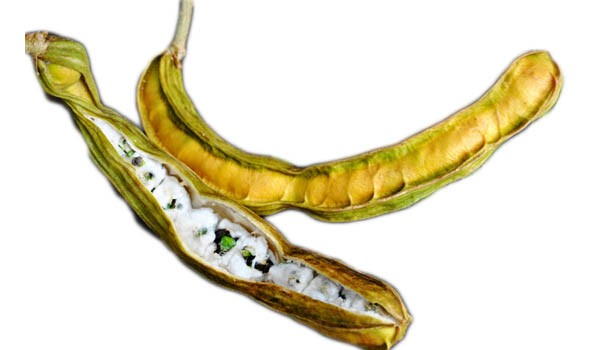- Overview
Common name: Ice cream bean, guaba, inga cipo, guamo bejuro, pois sucre, rabo de mico, inga de metro, monkey tail
Botanical name: INGA EDULIS Family: Fabaceae (Leguminosae)
Origin: Amazon Damage temp: 28 F
Extremely Rare Ice Cream Bean Tree in a 3 gallon container. A large tree which produces bean pods up to 1 meter long which contain sweet, juicy, white pulp that has a soft cotton wool texture and tastes of vanilla ice-cream. Comes from Central and Southern America. Also know as guaba, inga cipo, guamo bejuro, pois sucre, rabo de mico, inga de metro, monkey tail. Makes a delectable snack for children.
Uses
Folk Medicine
Chemistry
Description
Germplasm
Distribution
Ecology
Cultivation
Harvesting
Yields and Economics
EnergyPlants cultivated for the edible white pulp of the fruits, eaten out of hand or used in flavoring various desserts. Trees extensively used in Central and South America for shade for cacao, coffee, tea and vanilla, especially at lower altitudes, and for parks, avenues, and watershed preservation. Allen and Allen (1981) note that Inga species have been associated with cacao and coffee since pre-Colombian times, their desirability enhanced by their: (1) rapid growth for quick shade, (2) ability to withstand drastic pruning, (3) usefulness in maintaining soil fertility, and (4) effectiveness in preventing erosion. Colombian Indians prepare an alcoholic beverage from the aril. The beverage, called cachiri, is consumed at a festival of the same name. Choco Indians of Panama use this or related species for making their upright house beams, believing they do not rot in contact with the soil (Duke, 1970). Nearly half the Choco houses have this tree cultivated nearby.
According to Garcia-Barriga (1975), nearly all Colombian species of Inga are used in popular medicine. Decoctions of the leaves and bark are used as astringent in diarrhea, as a lotion for arthritis and rheumatism. The root decoction is used for diarrhea or dysentery, considered more effective if mixed with the rind of pomegranate. Bark and fruit are used for dropsy and irritations of the raucous lining of the intestines. Cuna Indians used the plant as a nervine for headaches (Duke, 1975).
Seeds of Inga edulis, eaten as vegetables, are reported to contain per 100 g, 118 calories, 63.3% moisture, 10.7 g protein, 0.7 g fat, 24.0 g total carbohydrate, 1.6 g fiber, 1.3 g ash. Pulp of Inga spp. contains per 100 g, 60 calories, 83.0% moisture, 1.0 g protein, 0.1 g fat, 15.5 g total carbohydrate, 1.2 g fiber, 0.4 g ash. Dried seeds of Inga spp. contain per 100 g, 339 calories, 12.6% moisture, 18.9 g protein, 2.1 g fat, 62.9 g total carbohydrate, 3.4 g fiber, 3.5 g ash. Seeds of the genus Inga are reported to contain trypsin inhibitors and chymotrypsin inhibitors.
Small trees up to 17 m tall, with broad spreading crown, almost flat; bark gray; trunk usually contorted, cylindrical, 30 cm or more in diameter and branching 1–2 m from base; leaves simply pinnate, 10–30 cm long, with 4–6 pairs of large oval leaflets, each pair separated by a winged rachis, the smallest pair below, the terminal leaflet 1.5 dm long and half as broad, membranous, minutely pubescent on both surfaces; flowers fragrant, sessile, solitary, arranged in crowded heads at tips of stems, peduncles 2–4 cm long, or flowers may be solitary in upper axils and fasciculate and subcorymbose below; calyx puberulent, striate, 5–8 mm long; corolla silky-villous, 14–20 mm long; bractlets oblong-lanceolate, about 5 mm long, caduous by full anthesis; pods with very thickened sulcate margins, 4-angled, up to 2 m long, 1–3 cm in diameter, flat or twisted, with white sweet pulp surrounding the seeds. Fl. Feb.–May; fr. several months later.
Assigned to the Middle America Center of Diversity, ice-cream bean, or cultivars thereof, is reported to exhibit tolerance to heavy soil, slope, and waterlogging. (2n = 26).
Native to Central and South America, from Mexico Southward. Introduced to Tanzania, and probably elsewhere in the tropics.
Abundant along margins of large rivers; common in thickets usually below the high-water mark, and in wooded swamps. Also in ravines, upland woods at edge of rivers and adjacent rainforests. Requires a tropical climate with plenty of moisture. Found from sea level to 2,200 m where there is no frost. Ranging from Subtropical Dry to Moist through Tropical Dry to Wet Forest Life Zone, ice-cream bean is reported to tolerate annual precipitation of 6.4 to 40.0 dm (mean of 9 cases = 16.9 dm), annual mean temperature of 21.3 to 27.3°C (mean of 9 cases = 25.1°C), and pH of 5.0 to 8.0 (mean of 7 cases = 6.6).
Propagates naturally by seeds in the forest. Planted from seedlings grown in nursery and then arranged so as to give maximum shade to coffee, tea or cacao plants grown beneath.
Fruits are harvested when ripe for the pulp, as needed. No great amount of fruit is harvested at once. Once established, trees provide shade, for many years over the undercrop of coffee, tea or cacao.
Fruits are produced periodically, and nearly continuously. Plants cultivated locally for the fruits in various tropical countries, as in South America, Hawaii, West Indies, and East Africa. Trees also extensively used for shade of coffee, tea, and cacao, especially in Central America.
Energy
Cuttings from Inga trees, which need constant pruning, furnish fuel. I estimate that the prunings from Inga as a coffee shade tree might add up to 5 MT/ha/yr, the pods, to 2 m long, might contribute significant biomass, and the aril can be fermented to make alcohol. Yield figures are not available. The species is reported to have N-fixing nodules. Inga jinicuil has been reported to fix 35 kg N/ha. - Features
weight: 9.99 lbs : - ReviewsThere is no reviews yet...Be the first!
Be the first to write a review of this product!



